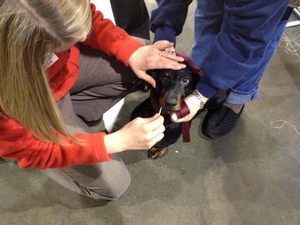My last blog talked about the basics of two types of inheritance for genetic conditions found in dogs: dominant and recessive. To review, dominant conditions need one copy of the mutated gene in order for the dog to show symptoms. Recessive conditions need both copies of the mutated gene inherited from each parent to have the disease. Knowing the difference can change the way breeders choose which dogs to breed. However, the wonderful world of genetics is not that simple. Another pattern of inheritance is called X-linked, or sex-linked. Although it is not as common as dominant and recessive; it is important to know which diseases follow this inheritance pattern, because it may impact breeding.
Dogs have 39 pairs of chromosomes (humans have 23). Something dogs and humans have in common is the X and Y chromosomes determine gender. XX is a female while XY is a male. Females always give away an X chromosome to their offspring. So, it is the male that determines gender for the next generation. If he passes on the X chromosome, the offspring is female. If he passes on the Y chromosome ...







